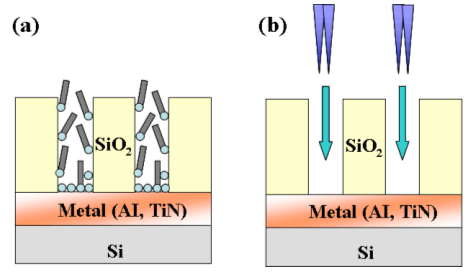
| WASEDA UNIVERSITY |
 |
|
|
||
|
In case of synthesizing carbon nanotube (CNT) with chemical vapor deposition (CVD) CNTs have a tendency of growing from catalyst particles. For wiring application, vertically aligned CNTs bundles grown from via holes can be used as the vertical interconnects bridging upper and lower layer of LSI multilayer. Therefore, the most important technology for interconnects application is forming catalyst particles at the bottom of nano size via holes. Although catalysts can normally be formed by sputtering and electron beam deposition, these methods have difficulty in depositing catalysts with high accuracy to the bottom of via holes. Figure 1(a) shows the catalysts formed at the via holes by sputtering. However, when the via diameter becomes small, the catalysts are deposited at the side wall of via holes and it is difficult to deposit catalysts in a controlled amount at the bottom of the via holes by sputtering. As shown in Fig. 1(b), ion implantation is a very interesting method for solving this problem. Ion implantation has high directional characteristics and catalysts can be implanted at the bottom of via holes in precisely controlled amounts. In this study, a focused-ion-beam (FIB) system was used as ion implantation method. The FIB has already been used to server and connect the LSI interconnects and can be applied easily in LSI processes. The FIB can irradiate ion beam as stated below. First, ions are occurred by applying the voltage to liquid metal ion source (LMIS) and the ion beam is focused by the first lens. Usually, the objective element to be ionized and other elements are used as LMIS to lower the melting point of the ion source. To extract the objective ion from LMIS, ions are mass separated by applying electric field and magnetic field to the beam using a E×B mass separator. Then, the output of the ion beam is controlled by passing the beam through a hole having a specific size and the ion beam is focused again by the second lens. The diameter of the beam is focused to about 10 -20 nm and the beam is irradiated to the sample on a stage. |
||

Fig.1 (a) Deposition of catalysts at the bottom of via holes using sputtering |
||
|
We have succeeded in growing CNTs by forming catalyst particles on SiO2 using the ion implantation whose ion source is Ni (Fig. 2). From now on, we aim at fabricating the structure which has via holes and growing CNTs by forming catalyst particles at the bottom of via holes for wiring application. |
||
|
Fig.2 (a) CNTs grown from catalysts formed by ion implantation |
||
Refecence [1] T. Iwasaki, R. Morikane, T. Edura, M. Tokuda, K. Tsutsui, Y. Wada, H. Kawarada "Growth of Dense Single-walled Carbon Nanotubes in Nano-sized Silicon Dioxide Holes for Future Microelectronics", Carbon, 45, 2351-2355 (2007) |
||